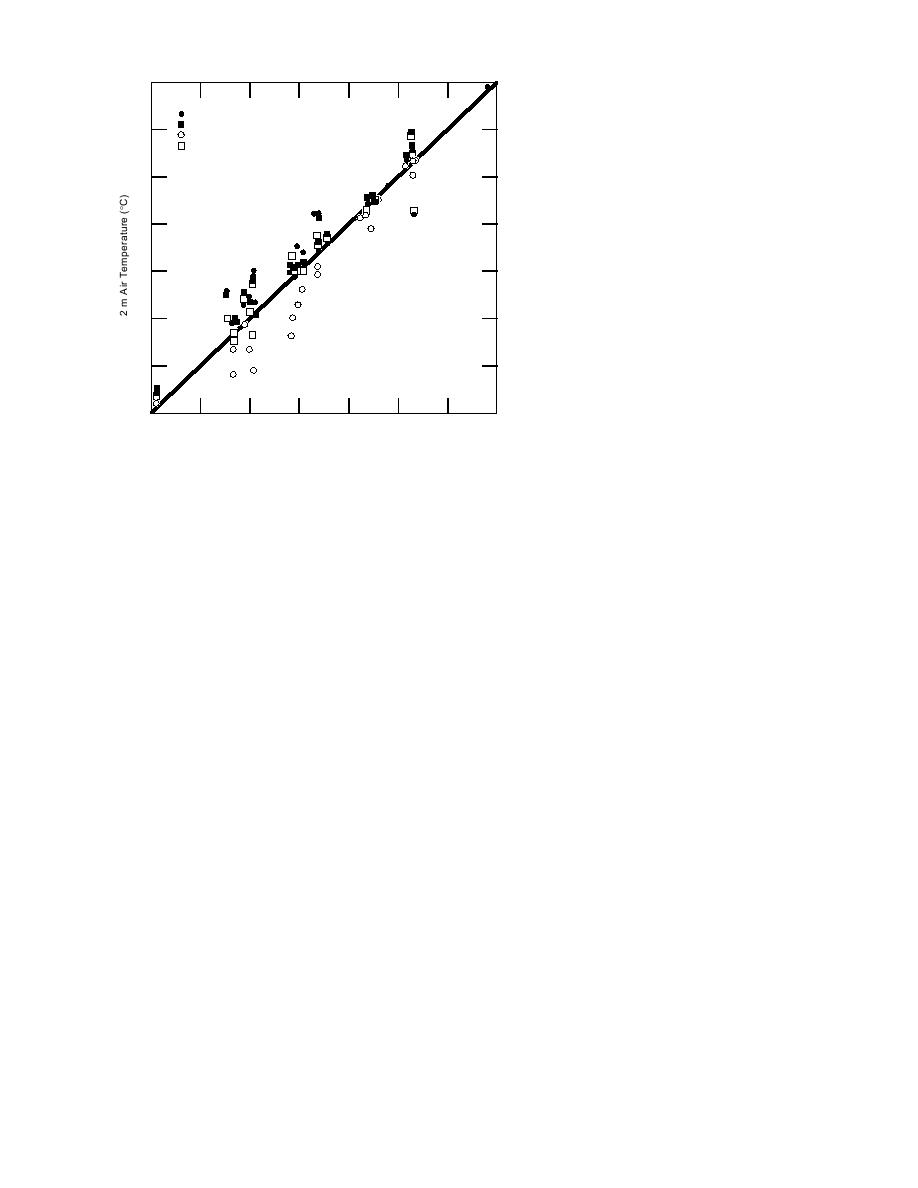
air temperature along the 045 radial be-
0
tween Z and W, the 1.25-m temperature at
2 m Temp., (Z) 267 m
W, and the 1.25-m temperature observed
2 m Temp., (z) 245 m (0.27 km, 045)
5
2 m Temp., (W) 234 m (0.61 km, 090)
at e (projected to the 090 radial in Fig. 15)
2 m Temp., (e) 254 m (1.04 km, 120)
are plotted against this 2-cm temperature
in Figure 16. The elevation of each mea-
10
suring point and its relative direction from
Z are tabulated in the data block in Figure
15
16. The 1.25-m air temperature in the ba-
sin (W) is most frequently less than the
temperatures around the basin, and is 1 to
20
5C less than the 2-cm temperature above
the basin in many cases.
The observation path was continued be-
25
yond the apex of observation A to the In-
dian Pond basin (X) at a on several
30
mornings. The observations along Aa
were used in conjunction with the obser-
vations along the usual path to construct
35
35
30
25
20
15
10
5
0
a temperaturetopographic cross-sectional
2 cm Air Temperature (C), 265 m (Z reference)
analysis. This enlarged elevation section
Figure 16. Temperatures in and around basin II compared with
is shown in Figure 17. The temperatures
the 2-cm temperature at Z. The temperature in basin II is
observed at 0630 on 7 February 1993, the
consistently less than the 2-cm temperature on the slope above.
coldest morning of the three winters (1990
1993), are plotted on the cross section in
Figure 17, and as one of the significant
basin is shown in the east (090) radial section;
vertical profiles of air temperature in the Con-
the northeast radial section (045) shows the broad-
necticut Valley, in Figure 18a.
ening of the basin at W, and the north (360) ra-
Very strong, cold advection with surface wind
dial the narrowing of the basin at the entrance to
of 510 m/s was present throughout the area on 6
the valley. The narrow valley is shown in the 315
February 1993. At 2130 EST, the surface winds
radial, and the valley begins to broaden into a
had diminished, and the temperature at W was
basin (III) in the 270 radial section. The nature of
30.8C, this being the lesser of several air tem-
Basin II surrounding W is not readily apparent in
peratures measured in the vicinity that evening.
a westeast elevation section, but the bounded
Warm advection increased the temperature at Mt.
Washington to 20C by 0630 on 7 February, but
basin is quite apparent in the cross section along
the 045 radial in Figure 15.
radiational cooling and inversion strengthening
The basin (II) surrounding W may receive air
continued in the study area. Air temperature be-
draining from the adjacent slopes (Yasuda et al.
low the ridge tops was consistently less than
30C during the 06150700 period of observa-
1986) and retains it through boundary damming
by the more wooded terrain (Baines 1979, Raynor
tion. The points Aa on the posterior of the ridge
1971) along the valley (Yasuda et al. 1986) which
from A as in Figure 17 are shown by open circles
drains the basin on the west. A thin stagnant
in Figure 18a. The coldest air was in basins (I) and
layer in the bottom of the basin could then con-
(II), evident in both Figure 17 and Figure 18a.
tain cooler air than found nearby. A test of this
Lapse structure was present from river level to
premise was performed during winter 1993. A
230 m although considerable temperature differ-
series of temperature measurements, 2 cm and 2
ences occurred at each elevation. Examining the
m above the snow, were obtained at the fixed site
cross section of these air temperatures with re-
Z to compare near snow temperature along the
spect to terrain in Figure 17 indicates that the
slope to the air temperature in the basin. The
isotherms quite consistently intersect the ridges,
temperature measured at 2 cm at point Z during
and that the Clay Hollow and Indian Pond sides
JanuaryFebruary 1993 is defined as the reference,
of the barrier ridge have similar air temperature
and plotted as the abscissa in Figure 16. The cor-
structure. The inversion isotherms above Clay
responding 2-m air temperature at Z, the 1.25-m
Hollow and Indian Pond are quite closely packed,
20



 Previous Page
Previous Page
